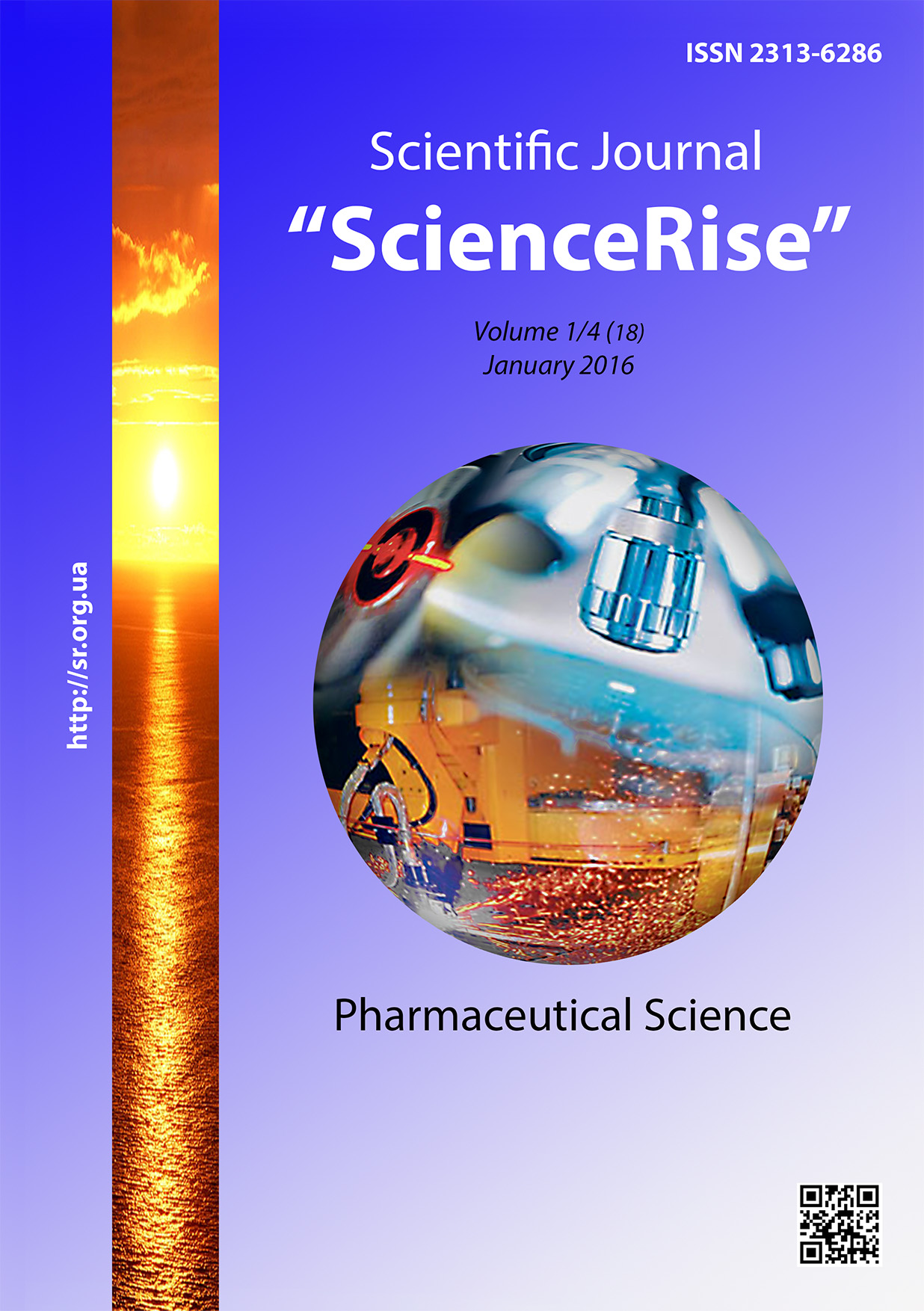Determination of the authenticity of lemon balm leaves by morphological and anatomical features
DOI:
https://doi.org/10.15587/2313-8416.2016.59036Keywords:
the authenticity, lemon balm, leaf, macroscopic features, microscopic features, properties, the useAbstract
Lemon balm herb is successfully used for medicinal purposes. Remedies containing lemon balm have sedative, antispasmodic, and antibacterial properties.
Quality of the original herbal material is important when using herbal remedies. Therefore, in herbal material harvesting special attention is paid to determination of its authenticity, and one of its components is specification of macroscopic and microscopic diagnostic features.
Aim. The purpose of the given research was determination of the authenticity of lemon balm leaves by morphological and anatomical features.
Methods. Samples of lemon balm leaves, gathered in Kharkov region, and fixed in the mixture of ethanol, glycerin and water, have been used for research. Light microscopy methods have been used for study of cells and tissues of lemon balm leaves.
Results. The main diagnostic morphological features, regulated by the State Pharmacopoeia of Ukraine 2.0 Monograph “Melissa leaf”, have been determined by macroscopic analysis: the leaf blade size and shape (the leaf blade is broadly ovoid, up to about 8 cm long and 5 cm wide, with pointed tip, and has rounded or cordate base), the margin shape (the leaf margins are crenate or roughly dentate); the lamina’s color and venation (the upper surface is bright green, the lower surface is pale green, with conspicuous midrib and raised reticulate venation); leaf pubescence (diffuse trichomes occur on the upper surface and on the lower surface along the veins).
At microscopic research the powder must show fragments of the leaf upper epidermis (top view) cells with sinuous walls, sometimes with palisade surrounding parenchyma; fragments of the leaf lower epidermis with diacytic stomata; typical trichomes (short, straight, unicellular, conical covering trichomes; multicellular, uniseriate covering trichomes with pointed ends; secretory trichomes); eight-celled secretory glands of the lamiaceous type (top view).
Conclusion. The authenticity of lemon balm leaves by macroscopic and microscopic features has been determined. Diagnostic morphological and microscopic features, regulated by the State Pharmacopoeia of Ukraine 2.0 Monograph “Melissa leaf”, have been defined in the studied herbal material
References
Gudzenko, A. V. (2010). Vmist biologichno-aktyvnyh rechovyn ta antyradykal'ni vlastyvosti spyrtovyh nastojok travy melisy likars'koi' (Melissa officinalis L.). Farmakologija ta likars'ka toksykologija, 5 (18), 17–23.
Shpychak, O. S. (2013). Marketyngovi doslidzhennja farmacevtychnogo rynku sedatyvnyh likars'kyh zasobiv roslynnogo pohodzhennja dlja vykorystannja u sportyvnij medycyni. Visnyk farmacii', 3 (75), 64–68.
Kennedy, D. O., Scholey, A. B., Tildesley, N. T. J., Perry, E. K., Wesnes, K. A. (2002). Modulation of mood and cognitive performance following acute administration of Melissa officinalis (lemon balm). Pharmacology Biochemistry and Behavior, 72 (4), 953–964. doi: 10.1016/s0091-3057(02)00777-3
Kennedy, D. O., Little, W., Haskell, C. F., Scholey, A. B. (2006). Anxiolytic effects of a combination ofMelissa ofcinalis andValeriana ofcinalis during laboratory induced stress. Phytotherapy Research, 20 (2), 96–102. doi: 10.1002/ptr.1787
Sokolov, P. D. (Ed.) (1991). Rastitel'nye resursy SSSR: Cvetkovye rastenija, ih himicheskij sostav, ispol'zovanie. Semejstva Hippuridaceae – Lobeliaceae. Sankt-Peterburg.: Nauka, 10–112.
Cvelev, N. N. (1981). Semejstvo gubocvetnye (Lamiaceae, ili Labiatae). Vol. 5, Chep. 2. Zhizn' rastenij. Moscow: Prosveshhenie, 404–412.
Grodzins'kyj, A. M. (Ed.) (1992). Likars'ki roslyny: Encyklopedychnyj dovidnyk. Kyiv, 544.
Mahlajuk, V. P. (1991). Lekarstvennye rastenija v narodnoj medicine. Saratov, 615.
Popova, N. V., Litvinenko, V. I. (2009). Voprosy standartizacii lekarstvennogo rastitel'nogo syr'ja – melissy list'ev. Farmakom, 2, 45–50.
Popova, N. V. (2013). Rozmarinovaja kislota v farmakopejnih rastenijah. Farmakom, 1, 27–31.
Derzhavna Farmakopeja Ukrai'ny. Vol. 3 (2014). Kharkiv: DP “Ukrai'ns'kyj naukovyj Farmakopejnyj centr jakosti likars'kyh zasobiv”, 389–391.
Serbin, A. G., Kartmazova, L. S., Rudenko, V. P., Gontovaja, T. N. (2006). Atlas po anatomii rastenij. Kharkiv: Kolorit, 86.
Downloads
Published
Issue
Section
License
Copyright (c) 2016 Олена Валеріївна Савельєва, Інна Миколаївна Владимирова, Людмила Михайлівна Сіра

This work is licensed under a Creative Commons Attribution 4.0 International License.
Our journal abides by the Creative Commons CC BY copyright rights and permissions for open access journals.
Authors, who are published in this journal, agree to the following conditions:
1. The authors reserve the right to authorship of the work and pass the first publication right of this work to the journal under the terms of a Creative Commons CC BY, which allows others to freely distribute the published research with the obligatory reference to the authors of the original work and the first publication of the work in this journal.
2. The authors have the right to conclude separate supplement agreements that relate to non-exclusive work distribution in the form in which it has been published by the journal (for example, to upload the work to the online storage of the journal or publish it as part of a monograph), provided that the reference to the first publication of the work in this journal is included.

